Leadership Analysis: Micro, Macro, and Competitiveness
VerifiedAdded on 2023/01/10
|75
|19344
|23
Report
AI Summary
This report provides an in-depth analysis of leadership, focusing on both micro and macro perspectives and their impact on organisational competitiveness. The study examines the case of Innovative Frequency Est. (IFE), an IT company in Saudi Arabia, to understand how leadership characteristics influence business operations and sustainability. The report explores the concepts of micro and macro leadership, leadership characteristics required for competitiveness, and the potential impact of leadership on IFE's performance. The research methodology includes a literature review and a quantitative approach using questionnaires. The report aims to identify effective leadership strategies to guide business operations towards growth and advancement. The structure includes an introduction, literature review, methodology, data analysis, discussion, conclusion, and recommendations, providing a comprehensive overview of the topic.
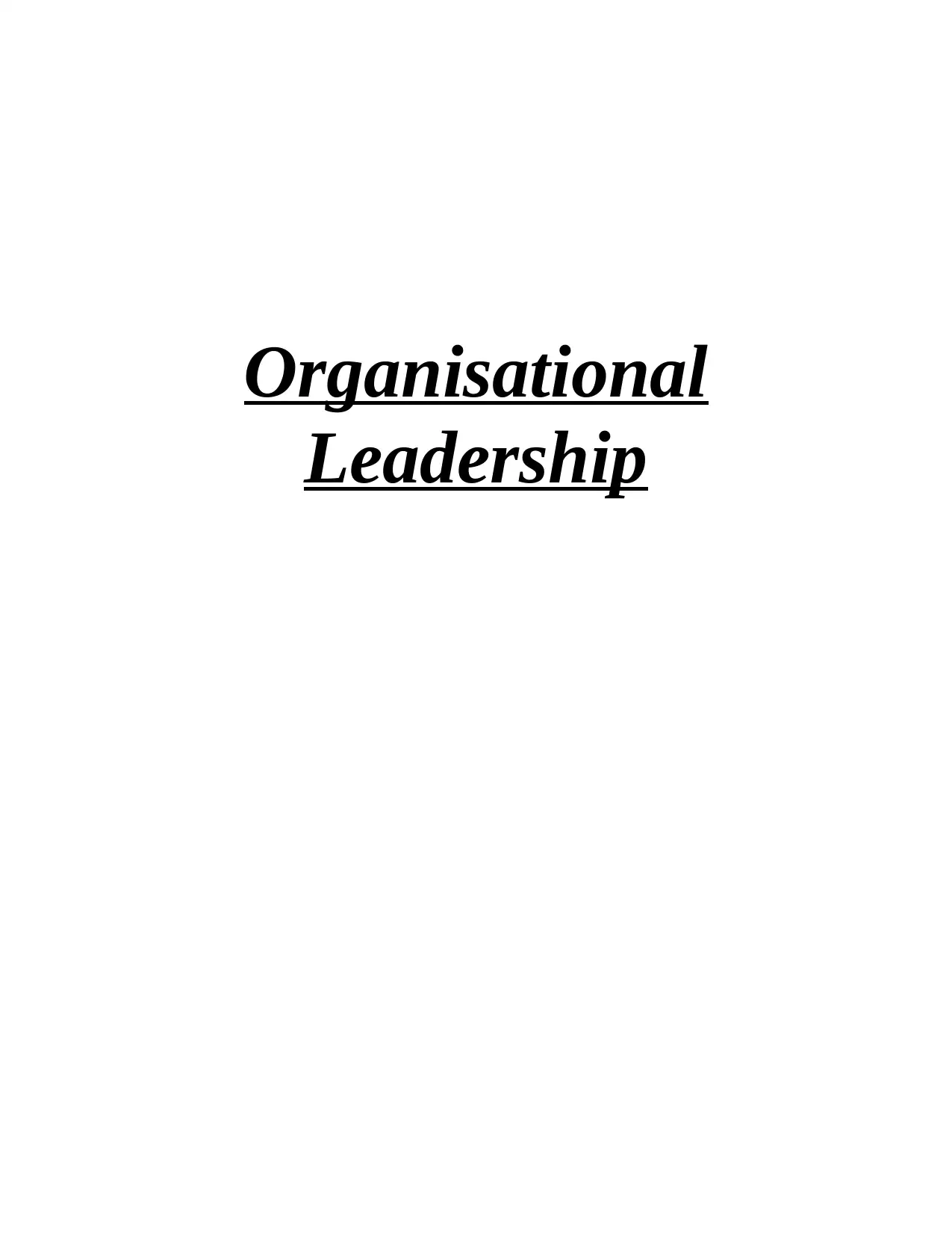
Organisational
Leadership
Leadership
Paraphrase This Document
Need a fresh take? Get an instant paraphrase of this document with our AI Paraphraser
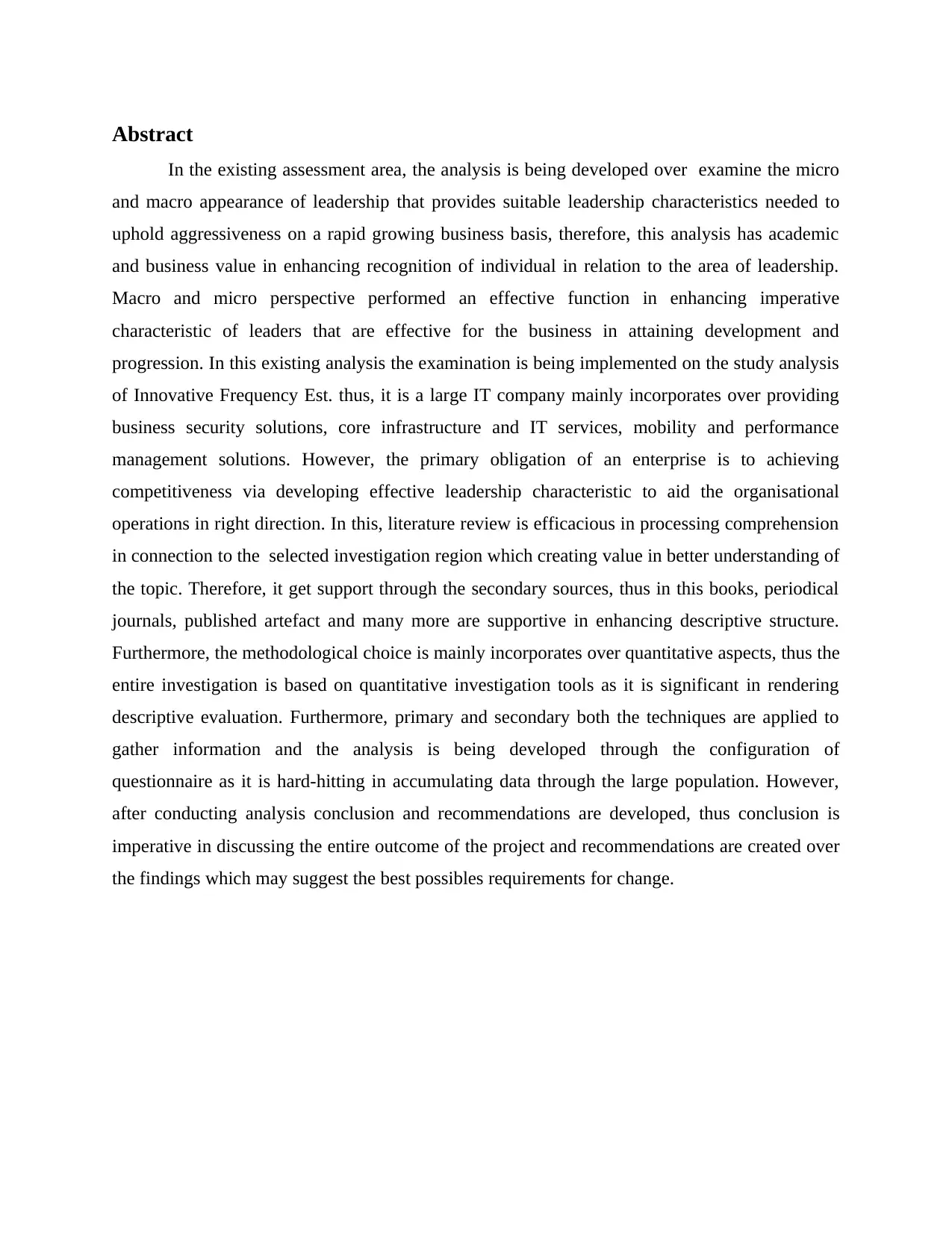
Abstract
In the existing assessment area, the analysis is being developed over examine the micro
and macro appearance of leadership that provides suitable leadership characteristics needed to
uphold aggressiveness on a rapid growing business basis, therefore, this analysis has academic
and business value in enhancing recognition of individual in relation to the area of leadership.
Macro and micro perspective performed an effective function in enhancing imperative
characteristic of leaders that are effective for the business in attaining development and
progression. In this existing analysis the examination is being implemented on the study analysis
of Innovative Frequency Est. thus, it is a large IT company mainly incorporates over providing
business security solutions, core infrastructure and IT services, mobility and performance
management solutions. However, the primary obligation of an enterprise is to achieving
competitiveness via developing effective leadership characteristic to aid the organisational
operations in right direction. In this, literature review is efficacious in processing comprehension
in connection to the selected investigation region which creating value in better understanding of
the topic. Therefore, it get support through the secondary sources, thus in this books, periodical
journals, published artefact and many more are supportive in enhancing descriptive structure.
Furthermore, the methodological choice is mainly incorporates over quantitative aspects, thus the
entire investigation is based on quantitative investigation tools as it is significant in rendering
descriptive evaluation. Furthermore, primary and secondary both the techniques are applied to
gather information and the analysis is being developed through the configuration of
questionnaire as it is hard-hitting in accumulating data through the large population. However,
after conducting analysis conclusion and recommendations are developed, thus conclusion is
imperative in discussing the entire outcome of the project and recommendations are created over
the findings which may suggest the best possibles requirements for change.
In the existing assessment area, the analysis is being developed over examine the micro
and macro appearance of leadership that provides suitable leadership characteristics needed to
uphold aggressiveness on a rapid growing business basis, therefore, this analysis has academic
and business value in enhancing recognition of individual in relation to the area of leadership.
Macro and micro perspective performed an effective function in enhancing imperative
characteristic of leaders that are effective for the business in attaining development and
progression. In this existing analysis the examination is being implemented on the study analysis
of Innovative Frequency Est. thus, it is a large IT company mainly incorporates over providing
business security solutions, core infrastructure and IT services, mobility and performance
management solutions. However, the primary obligation of an enterprise is to achieving
competitiveness via developing effective leadership characteristic to aid the organisational
operations in right direction. In this, literature review is efficacious in processing comprehension
in connection to the selected investigation region which creating value in better understanding of
the topic. Therefore, it get support through the secondary sources, thus in this books, periodical
journals, published artefact and many more are supportive in enhancing descriptive structure.
Furthermore, the methodological choice is mainly incorporates over quantitative aspects, thus the
entire investigation is based on quantitative investigation tools as it is significant in rendering
descriptive evaluation. Furthermore, primary and secondary both the techniques are applied to
gather information and the analysis is being developed through the configuration of
questionnaire as it is hard-hitting in accumulating data through the large population. However,
after conducting analysis conclusion and recommendations are developed, thus conclusion is
imperative in discussing the entire outcome of the project and recommendations are created over
the findings which may suggest the best possibles requirements for change.
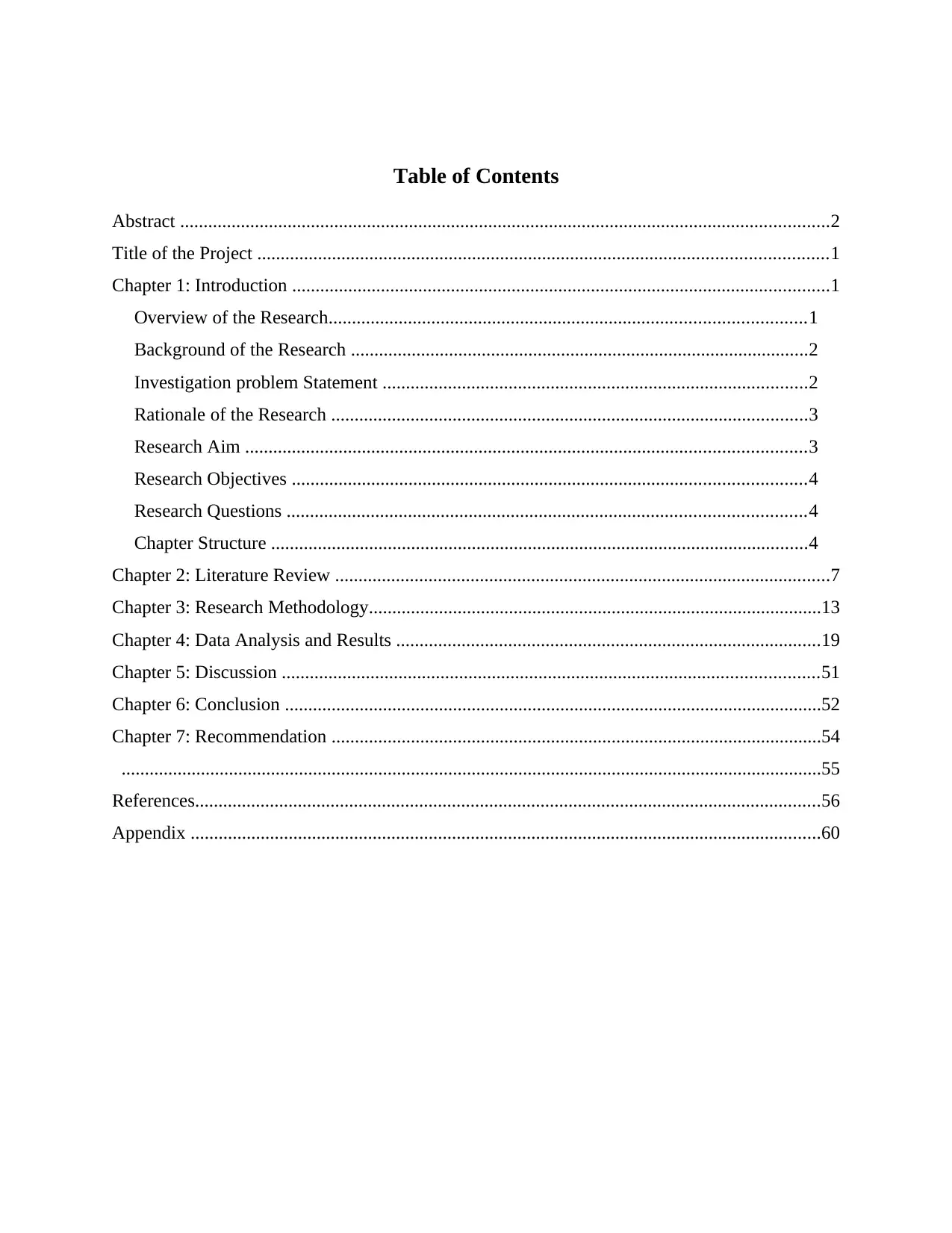
Table of Contents
Abstract ...........................................................................................................................................2
Title of the Project ..........................................................................................................................1
Chapter 1: Introduction ...................................................................................................................1
Overview of the Research......................................................................................................1
Background of the Research ..................................................................................................2
Investigation problem Statement ...........................................................................................2
Rationale of the Research ......................................................................................................3
Research Aim ........................................................................................................................3
Research Objectives ..............................................................................................................4
Research Questions ...............................................................................................................4
Chapter Structure ...................................................................................................................4
Chapter 2: Literature Review ..........................................................................................................7
Chapter 3: Research Methodology.................................................................................................13
Chapter 4: Data Analysis and Results ...........................................................................................19
Chapter 5: Discussion ...................................................................................................................51
Chapter 6: Conclusion ...................................................................................................................52
Chapter 7: Recommendation .........................................................................................................54
......................................................................................................................................................55
References......................................................................................................................................56
Appendix .......................................................................................................................................60
Abstract ...........................................................................................................................................2
Title of the Project ..........................................................................................................................1
Chapter 1: Introduction ...................................................................................................................1
Overview of the Research......................................................................................................1
Background of the Research ..................................................................................................2
Investigation problem Statement ...........................................................................................2
Rationale of the Research ......................................................................................................3
Research Aim ........................................................................................................................3
Research Objectives ..............................................................................................................4
Research Questions ...............................................................................................................4
Chapter Structure ...................................................................................................................4
Chapter 2: Literature Review ..........................................................................................................7
Chapter 3: Research Methodology.................................................................................................13
Chapter 4: Data Analysis and Results ...........................................................................................19
Chapter 5: Discussion ...................................................................................................................51
Chapter 6: Conclusion ...................................................................................................................52
Chapter 7: Recommendation .........................................................................................................54
......................................................................................................................................................55
References......................................................................................................................................56
Appendix .......................................................................................................................................60
⊘ This is a preview!⊘
Do you want full access?
Subscribe today to unlock all pages.

Trusted by 1+ million students worldwide

Paraphrase This Document
Need a fresh take? Get an instant paraphrase of this document with our AI Paraphraser
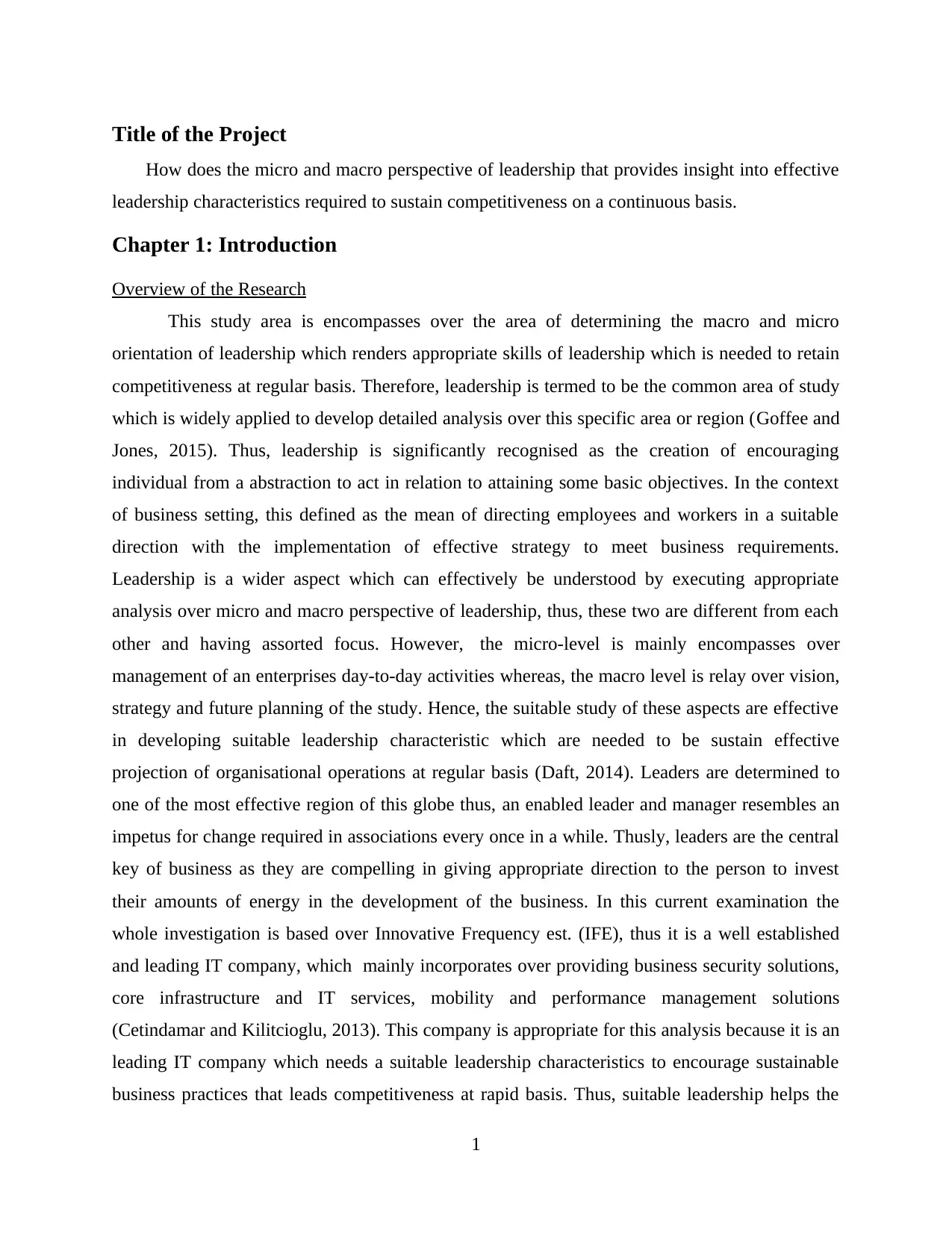
Title of the Project
How does the micro and macro perspective of leadership that provides insight into effective
leadership characteristics required to sustain competitiveness on a continuous basis.
Chapter 1: Introduction
Overview of the Research
This study area is encompasses over the area of determining the macro and micro
orientation of leadership which renders appropriate skills of leadership which is needed to retain
competitiveness at regular basis. Therefore, leadership is termed to be the common area of study
which is widely applied to develop detailed analysis over this specific area or region (Goffee and
Jones, 2015). Thus, leadership is significantly recognised as the creation of encouraging
individual from a abstraction to act in relation to attaining some basic objectives. In the context
of business setting, this defined as the mean of directing employees and workers in a suitable
direction with the implementation of effective strategy to meet business requirements.
Leadership is a wider aspect which can effectively be understood by executing appropriate
analysis over micro and macro perspective of leadership, thus, these two are different from each
other and having assorted focus. However, the micro-level is mainly encompasses over
management of an enterprises day-to-day activities whereas, the macro level is relay over vision,
strategy and future planning of the study. Hence, the suitable study of these aspects are effective
in developing suitable leadership characteristic which are needed to be sustain effective
projection of organisational operations at regular basis (Daft, 2014). Leaders are determined to
one of the most effective region of this globe thus, an enabled leader and manager resembles an
impetus for change required in associations every once in a while. Thusly, leaders are the central
key of business as they are compelling in giving appropriate direction to the person to invest
their amounts of energy in the development of the business. In this current examination the
whole investigation is based over Innovative Frequency est. (IFE), thus it is a well established
and leading IT company, which mainly incorporates over providing business security solutions,
core infrastructure and IT services, mobility and performance management solutions
(Cetindamar and Kilitcioglu, 2013). This company is appropriate for this analysis because it is an
leading IT company which needs a suitable leadership characteristics to encourage sustainable
business practices that leads competitiveness at rapid basis. Thus, suitable leadership helps the
1
How does the micro and macro perspective of leadership that provides insight into effective
leadership characteristics required to sustain competitiveness on a continuous basis.
Chapter 1: Introduction
Overview of the Research
This study area is encompasses over the area of determining the macro and micro
orientation of leadership which renders appropriate skills of leadership which is needed to retain
competitiveness at regular basis. Therefore, leadership is termed to be the common area of study
which is widely applied to develop detailed analysis over this specific area or region (Goffee and
Jones, 2015). Thus, leadership is significantly recognised as the creation of encouraging
individual from a abstraction to act in relation to attaining some basic objectives. In the context
of business setting, this defined as the mean of directing employees and workers in a suitable
direction with the implementation of effective strategy to meet business requirements.
Leadership is a wider aspect which can effectively be understood by executing appropriate
analysis over micro and macro perspective of leadership, thus, these two are different from each
other and having assorted focus. However, the micro-level is mainly encompasses over
management of an enterprises day-to-day activities whereas, the macro level is relay over vision,
strategy and future planning of the study. Hence, the suitable study of these aspects are effective
in developing suitable leadership characteristic which are needed to be sustain effective
projection of organisational operations at regular basis (Daft, 2014). Leaders are determined to
one of the most effective region of this globe thus, an enabled leader and manager resembles an
impetus for change required in associations every once in a while. Thusly, leaders are the central
key of business as they are compelling in giving appropriate direction to the person to invest
their amounts of energy in the development of the business. In this current examination the
whole investigation is based over Innovative Frequency est. (IFE), thus it is a well established
and leading IT company, which mainly incorporates over providing business security solutions,
core infrastructure and IT services, mobility and performance management solutions
(Cetindamar and Kilitcioglu, 2013). This company is appropriate for this analysis because it is an
leading IT company which needs a suitable leadership characteristics to encourage sustainable
business practices that leads competitiveness at rapid basis. Thus, suitable leadership helps the
1
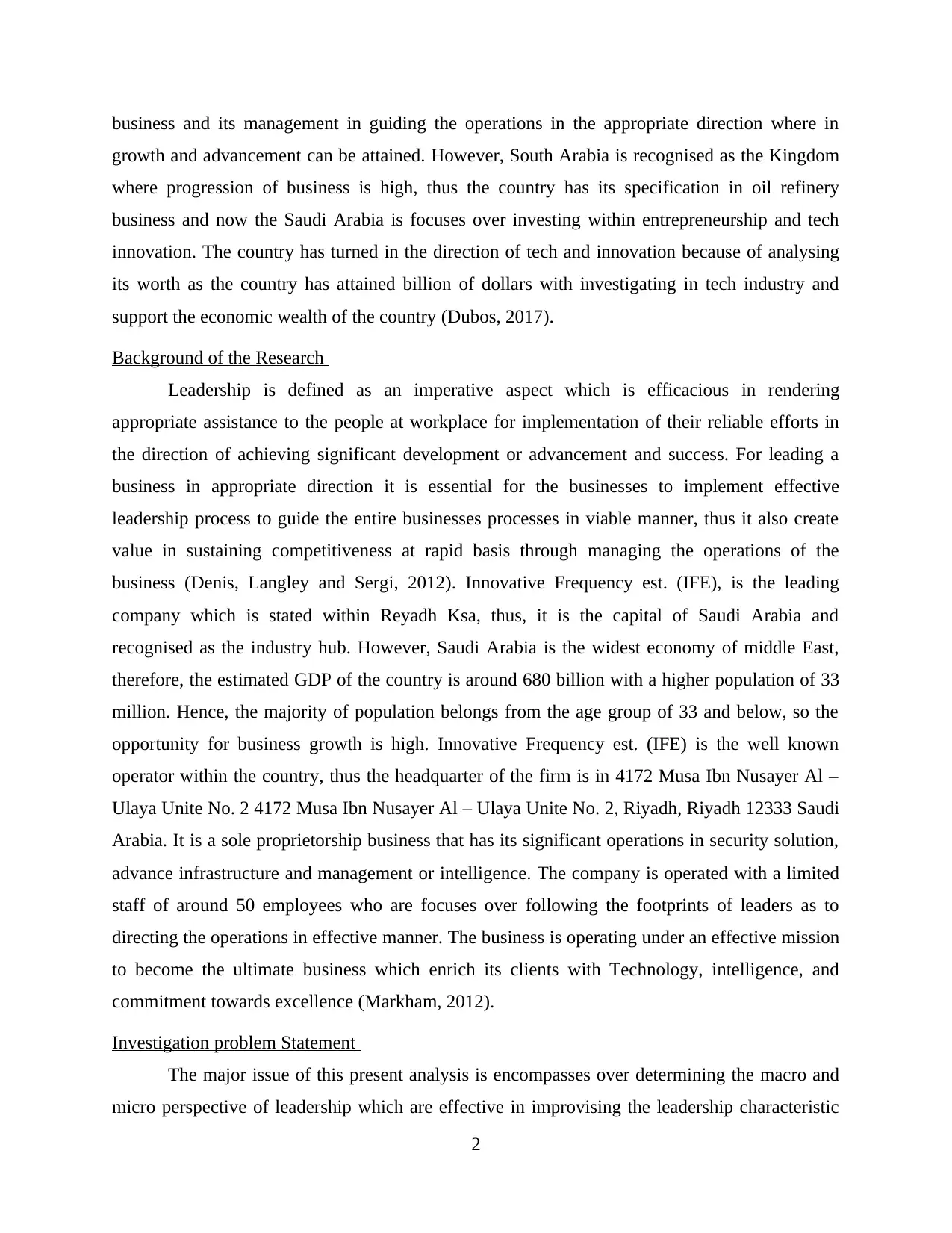
business and its management in guiding the operations in the appropriate direction where in
growth and advancement can be attained. However, South Arabia is recognised as the Kingdom
where progression of business is high, thus the country has its specification in oil refinery
business and now the Saudi Arabia is focuses over investing within entrepreneurship and tech
innovation. The country has turned in the direction of tech and innovation because of analysing
its worth as the country has attained billion of dollars with investigating in tech industry and
support the economic wealth of the country (Dubos, 2017).
Background of the Research
Leadership is defined as an imperative aspect which is efficacious in rendering
appropriate assistance to the people at workplace for implementation of their reliable efforts in
the direction of achieving significant development or advancement and success. For leading a
business in appropriate direction it is essential for the businesses to implement effective
leadership process to guide the entire businesses processes in viable manner, thus it also create
value in sustaining competitiveness at rapid basis through managing the operations of the
business (Denis, Langley and Sergi, 2012). Innovative Frequency est. (IFE), is the leading
company which is stated within Reyadh Ksa, thus, it is the capital of Saudi Arabia and
recognised as the industry hub. However, Saudi Arabia is the widest economy of middle East,
therefore, the estimated GDP of the country is around 680 billion with a higher population of 33
million. Hence, the majority of population belongs from the age group of 33 and below, so the
opportunity for business growth is high. Innovative Frequency est. (IFE) is the well known
operator within the country, thus the headquarter of the firm is in 4172 Musa Ibn Nusayer Al –
Ulaya Unite No. 2 4172 Musa Ibn Nusayer Al – Ulaya Unite No. 2, Riyadh, Riyadh 12333 Saudi
Arabia. It is a sole proprietorship business that has its significant operations in security solution,
advance infrastructure and management or intelligence. The company is operated with a limited
staff of around 50 employees who are focuses over following the footprints of leaders as to
directing the operations in effective manner. The business is operating under an effective mission
to become the ultimate business which enrich its clients with Technology, intelligence, and
commitment towards excellence (Markham, 2012).
Investigation problem Statement
The major issue of this present analysis is encompasses over determining the macro and
micro perspective of leadership which are effective in improvising the leadership characteristic
2
growth and advancement can be attained. However, South Arabia is recognised as the Kingdom
where progression of business is high, thus the country has its specification in oil refinery
business and now the Saudi Arabia is focuses over investing within entrepreneurship and tech
innovation. The country has turned in the direction of tech and innovation because of analysing
its worth as the country has attained billion of dollars with investigating in tech industry and
support the economic wealth of the country (Dubos, 2017).
Background of the Research
Leadership is defined as an imperative aspect which is efficacious in rendering
appropriate assistance to the people at workplace for implementation of their reliable efforts in
the direction of achieving significant development or advancement and success. For leading a
business in appropriate direction it is essential for the businesses to implement effective
leadership process to guide the entire businesses processes in viable manner, thus it also create
value in sustaining competitiveness at rapid basis through managing the operations of the
business (Denis, Langley and Sergi, 2012). Innovative Frequency est. (IFE), is the leading
company which is stated within Reyadh Ksa, thus, it is the capital of Saudi Arabia and
recognised as the industry hub. However, Saudi Arabia is the widest economy of middle East,
therefore, the estimated GDP of the country is around 680 billion with a higher population of 33
million. Hence, the majority of population belongs from the age group of 33 and below, so the
opportunity for business growth is high. Innovative Frequency est. (IFE) is the well known
operator within the country, thus the headquarter of the firm is in 4172 Musa Ibn Nusayer Al –
Ulaya Unite No. 2 4172 Musa Ibn Nusayer Al – Ulaya Unite No. 2, Riyadh, Riyadh 12333 Saudi
Arabia. It is a sole proprietorship business that has its significant operations in security solution,
advance infrastructure and management or intelligence. The company is operated with a limited
staff of around 50 employees who are focuses over following the footprints of leaders as to
directing the operations in effective manner. The business is operating under an effective mission
to become the ultimate business which enrich its clients with Technology, intelligence, and
commitment towards excellence (Markham, 2012).
Investigation problem Statement
The major issue of this present analysis is encompasses over determining the macro and
micro perspective of leadership which are effective in improvising the leadership characteristic
2
⊘ This is a preview!⊘
Do you want full access?
Subscribe today to unlock all pages.

Trusted by 1+ million students worldwide
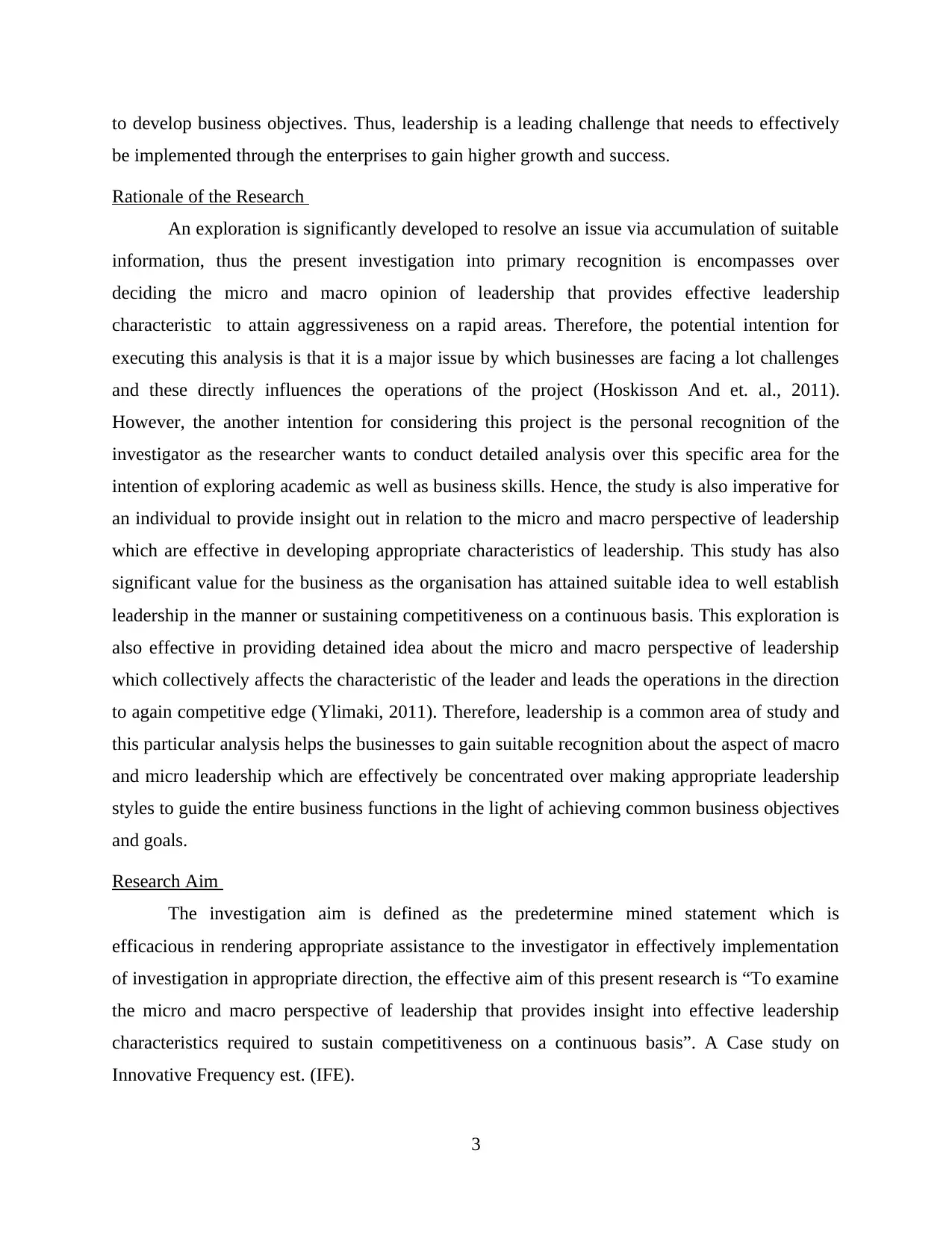
to develop business objectives. Thus, leadership is a leading challenge that needs to effectively
be implemented through the enterprises to gain higher growth and success.
Rationale of the Research
An exploration is significantly developed to resolve an issue via accumulation of suitable
information, thus the present investigation into primary recognition is encompasses over
deciding the micro and macro opinion of leadership that provides effective leadership
characteristic to attain aggressiveness on a rapid areas. Therefore, the potential intention for
executing this analysis is that it is a major issue by which businesses are facing a lot challenges
and these directly influences the operations of the project (Hoskisson And et. al., 2011).
However, the another intention for considering this project is the personal recognition of the
investigator as the researcher wants to conduct detailed analysis over this specific area for the
intention of exploring academic as well as business skills. Hence, the study is also imperative for
an individual to provide insight out in relation to the micro and macro perspective of leadership
which are effective in developing appropriate characteristics of leadership. This study has also
significant value for the business as the organisation has attained suitable idea to well establish
leadership in the manner or sustaining competitiveness on a continuous basis. This exploration is
also effective in providing detained idea about the micro and macro perspective of leadership
which collectively affects the characteristic of the leader and leads the operations in the direction
to again competitive edge (Ylimaki, 2011). Therefore, leadership is a common area of study and
this particular analysis helps the businesses to gain suitable recognition about the aspect of macro
and micro leadership which are effectively be concentrated over making appropriate leadership
styles to guide the entire business functions in the light of achieving common business objectives
and goals.
Research Aim
The investigation aim is defined as the predetermine mined statement which is
efficacious in rendering appropriate assistance to the investigator in effectively implementation
of investigation in appropriate direction, the effective aim of this present research is “To examine
the micro and macro perspective of leadership that provides insight into effective leadership
characteristics required to sustain competitiveness on a continuous basis”. A Case study on
Innovative Frequency est. (IFE).
3
be implemented through the enterprises to gain higher growth and success.
Rationale of the Research
An exploration is significantly developed to resolve an issue via accumulation of suitable
information, thus the present investigation into primary recognition is encompasses over
deciding the micro and macro opinion of leadership that provides effective leadership
characteristic to attain aggressiveness on a rapid areas. Therefore, the potential intention for
executing this analysis is that it is a major issue by which businesses are facing a lot challenges
and these directly influences the operations of the project (Hoskisson And et. al., 2011).
However, the another intention for considering this project is the personal recognition of the
investigator as the researcher wants to conduct detailed analysis over this specific area for the
intention of exploring academic as well as business skills. Hence, the study is also imperative for
an individual to provide insight out in relation to the micro and macro perspective of leadership
which are effective in developing appropriate characteristics of leadership. This study has also
significant value for the business as the organisation has attained suitable idea to well establish
leadership in the manner or sustaining competitiveness on a continuous basis. This exploration is
also effective in providing detained idea about the micro and macro perspective of leadership
which collectively affects the characteristic of the leader and leads the operations in the direction
to again competitive edge (Ylimaki, 2011). Therefore, leadership is a common area of study and
this particular analysis helps the businesses to gain suitable recognition about the aspect of macro
and micro leadership which are effectively be concentrated over making appropriate leadership
styles to guide the entire business functions in the light of achieving common business objectives
and goals.
Research Aim
The investigation aim is defined as the predetermine mined statement which is
efficacious in rendering appropriate assistance to the investigator in effectively implementation
of investigation in appropriate direction, the effective aim of this present research is “To examine
the micro and macro perspective of leadership that provides insight into effective leadership
characteristics required to sustain competitiveness on a continuous basis”. A Case study on
Innovative Frequency est. (IFE).
3
Paraphrase This Document
Need a fresh take? Get an instant paraphrase of this document with our AI Paraphraser
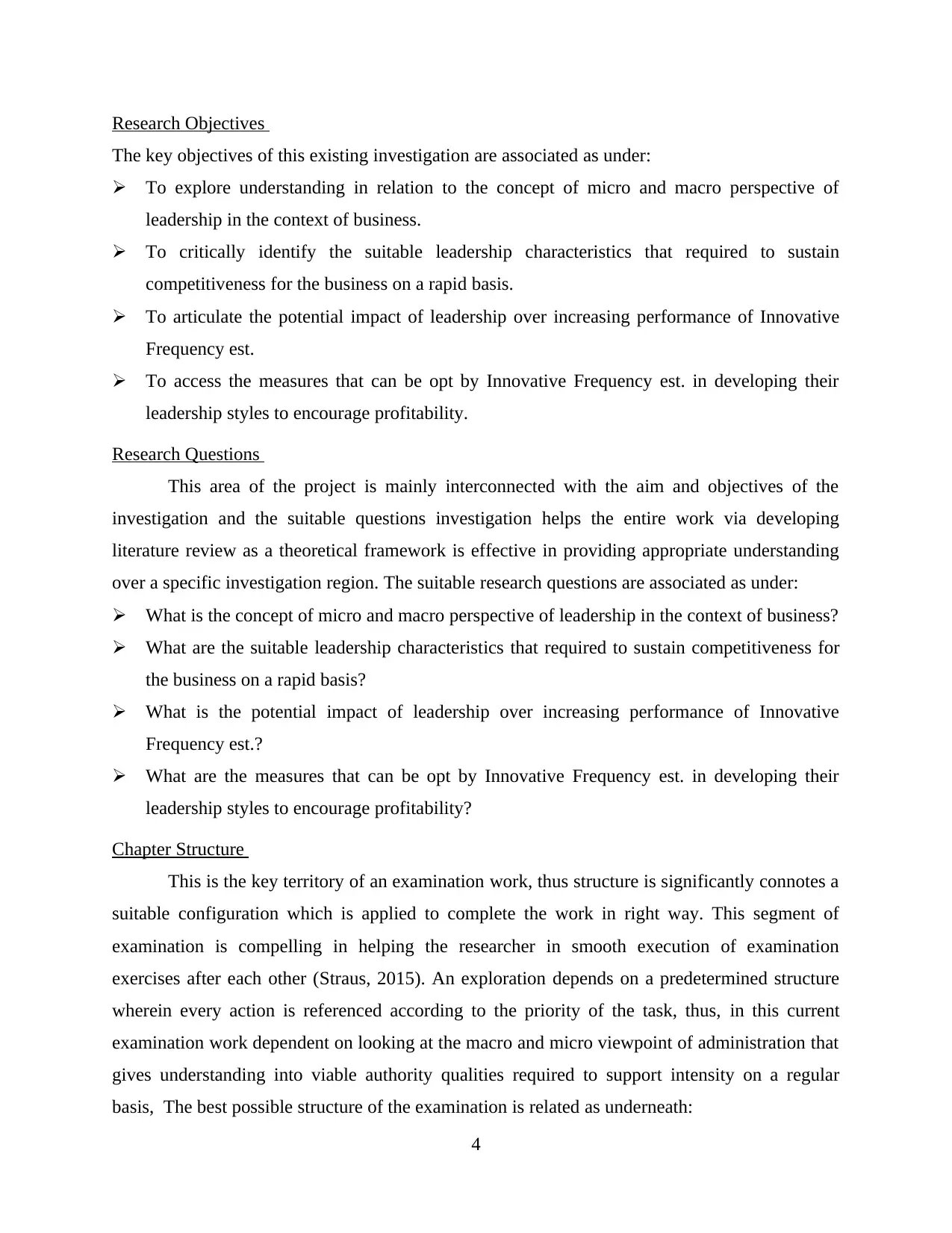
Research Objectives
The key objectives of this existing investigation are associated as under:
To explore understanding in relation to the concept of micro and macro perspective of
leadership in the context of business.
To critically identify the suitable leadership characteristics that required to sustain
competitiveness for the business on a rapid basis.
To articulate the potential impact of leadership over increasing performance of Innovative
Frequency est.
To access the measures that can be opt by Innovative Frequency est. in developing their
leadership styles to encourage profitability.
Research Questions
This area of the project is mainly interconnected with the aim and objectives of the
investigation and the suitable questions investigation helps the entire work via developing
literature review as a theoretical framework is effective in providing appropriate understanding
over a specific investigation region. The suitable research questions are associated as under:
What is the concept of micro and macro perspective of leadership in the context of business?
What are the suitable leadership characteristics that required to sustain competitiveness for
the business on a rapid basis?
What is the potential impact of leadership over increasing performance of Innovative
Frequency est.?
What are the measures that can be opt by Innovative Frequency est. in developing their
leadership styles to encourage profitability?
Chapter Structure
This is the key territory of an examination work, thus structure is significantly connotes a
suitable configuration which is applied to complete the work in right way. This segment of
examination is compelling in helping the researcher in smooth execution of examination
exercises after each other (Straus, 2015). An exploration depends on a predetermined structure
wherein every action is referenced according to the priority of the task, thus, in this current
examination work dependent on looking at the macro and micro viewpoint of administration that
gives understanding into viable authority qualities required to support intensity on a regular
basis, The best possible structure of the examination is related as underneath:
4
The key objectives of this existing investigation are associated as under:
To explore understanding in relation to the concept of micro and macro perspective of
leadership in the context of business.
To critically identify the suitable leadership characteristics that required to sustain
competitiveness for the business on a rapid basis.
To articulate the potential impact of leadership over increasing performance of Innovative
Frequency est.
To access the measures that can be opt by Innovative Frequency est. in developing their
leadership styles to encourage profitability.
Research Questions
This area of the project is mainly interconnected with the aim and objectives of the
investigation and the suitable questions investigation helps the entire work via developing
literature review as a theoretical framework is effective in providing appropriate understanding
over a specific investigation region. The suitable research questions are associated as under:
What is the concept of micro and macro perspective of leadership in the context of business?
What are the suitable leadership characteristics that required to sustain competitiveness for
the business on a rapid basis?
What is the potential impact of leadership over increasing performance of Innovative
Frequency est.?
What are the measures that can be opt by Innovative Frequency est. in developing their
leadership styles to encourage profitability?
Chapter Structure
This is the key territory of an examination work, thus structure is significantly connotes a
suitable configuration which is applied to complete the work in right way. This segment of
examination is compelling in helping the researcher in smooth execution of examination
exercises after each other (Straus, 2015). An exploration depends on a predetermined structure
wherein every action is referenced according to the priority of the task, thus, in this current
examination work dependent on looking at the macro and micro viewpoint of administration that
gives understanding into viable authority qualities required to support intensity on a regular
basis, The best possible structure of the examination is related as underneath:
4
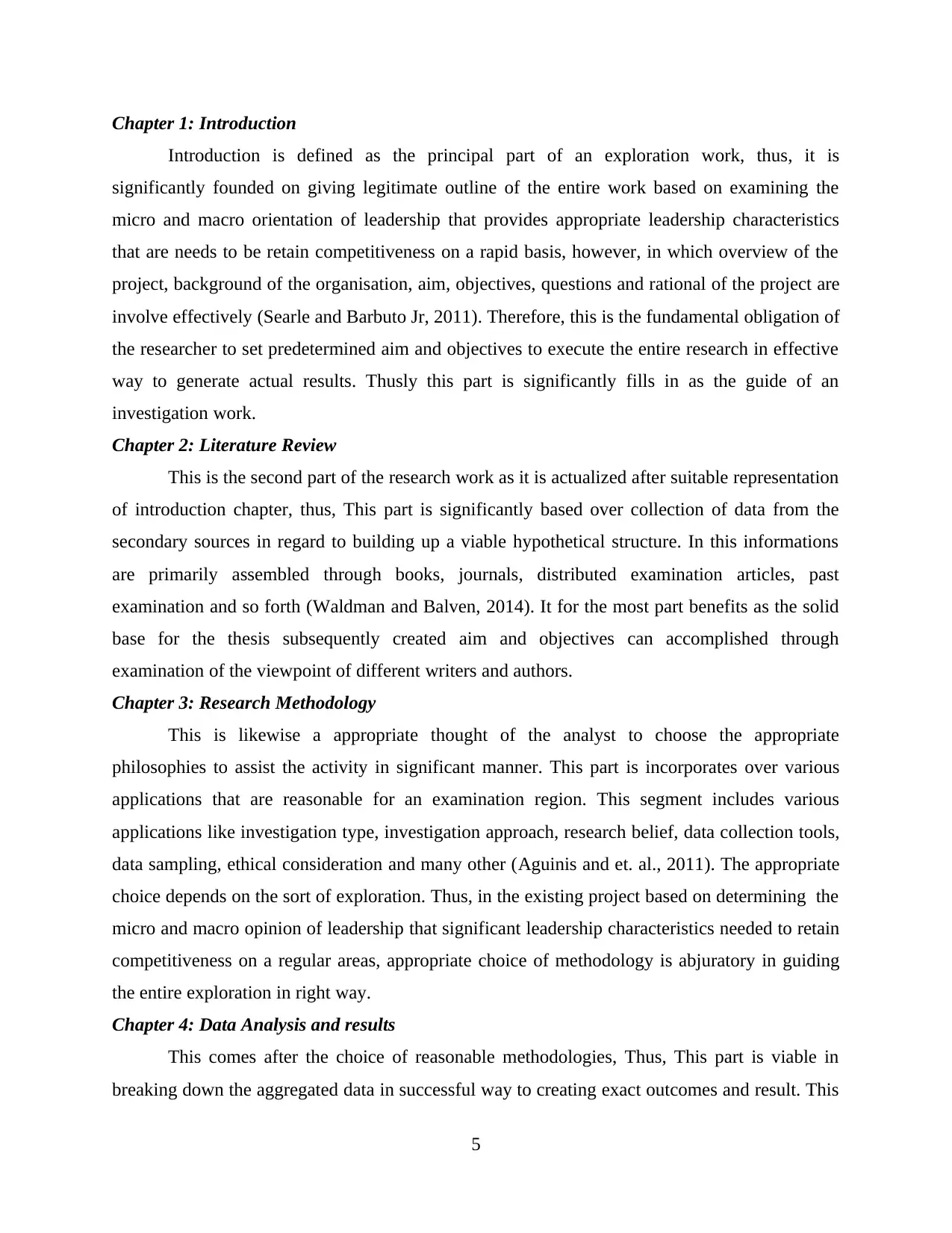
Chapter 1: Introduction
Introduction is defined as the principal part of an exploration work, thus, it is
significantly founded on giving legitimate outline of the entire work based on examining the
micro and macro orientation of leadership that provides appropriate leadership characteristics
that are needs to be retain competitiveness on a rapid basis, however, in which overview of the
project, background of the organisation, aim, objectives, questions and rational of the project are
involve effectively (Searle and Barbuto Jr, 2011). Therefore, this is the fundamental obligation of
the researcher to set predetermined aim and objectives to execute the entire research in effective
way to generate actual results. Thusly this part is significantly fills in as the guide of an
investigation work.
Chapter 2: Literature Review
This is the second part of the research work as it is actualized after suitable representation
of introduction chapter, thus, This part is significantly based over collection of data from the
secondary sources in regard to building up a viable hypothetical structure. In this informations
are primarily assembled through books, journals, distributed examination articles, past
examination and so forth (Waldman and Balven, 2014). It for the most part benefits as the solid
base for the thesis subsequently created aim and objectives can accomplished through
examination of the viewpoint of different writers and authors.
Chapter 3: Research Methodology
This is likewise a appropriate thought of the analyst to choose the appropriate
philosophies to assist the activity in significant manner. This part is incorporates over various
applications that are reasonable for an examination region. This segment includes various
applications like investigation type, investigation approach, research belief, data collection tools,
data sampling, ethical consideration and many other (Aguinis and et. al., 2011). The appropriate
choice depends on the sort of exploration. Thus, in the existing project based on determining the
micro and macro opinion of leadership that significant leadership characteristics needed to retain
competitiveness on a regular areas, appropriate choice of methodology is abjuratory in guiding
the entire exploration in right way.
Chapter 4: Data Analysis and results
This comes after the choice of reasonable methodologies, Thus, This part is viable in
breaking down the aggregated data in successful way to creating exact outcomes and result. This
5
Introduction is defined as the principal part of an exploration work, thus, it is
significantly founded on giving legitimate outline of the entire work based on examining the
micro and macro orientation of leadership that provides appropriate leadership characteristics
that are needs to be retain competitiveness on a rapid basis, however, in which overview of the
project, background of the organisation, aim, objectives, questions and rational of the project are
involve effectively (Searle and Barbuto Jr, 2011). Therefore, this is the fundamental obligation of
the researcher to set predetermined aim and objectives to execute the entire research in effective
way to generate actual results. Thusly this part is significantly fills in as the guide of an
investigation work.
Chapter 2: Literature Review
This is the second part of the research work as it is actualized after suitable representation
of introduction chapter, thus, This part is significantly based over collection of data from the
secondary sources in regard to building up a viable hypothetical structure. In this informations
are primarily assembled through books, journals, distributed examination articles, past
examination and so forth (Waldman and Balven, 2014). It for the most part benefits as the solid
base for the thesis subsequently created aim and objectives can accomplished through
examination of the viewpoint of different writers and authors.
Chapter 3: Research Methodology
This is likewise a appropriate thought of the analyst to choose the appropriate
philosophies to assist the activity in significant manner. This part is incorporates over various
applications that are reasonable for an examination region. This segment includes various
applications like investigation type, investigation approach, research belief, data collection tools,
data sampling, ethical consideration and many other (Aguinis and et. al., 2011). The appropriate
choice depends on the sort of exploration. Thus, in the existing project based on determining the
micro and macro opinion of leadership that significant leadership characteristics needed to retain
competitiveness on a regular areas, appropriate choice of methodology is abjuratory in guiding
the entire exploration in right way.
Chapter 4: Data Analysis and results
This comes after the choice of reasonable methodologies, Thus, This part is viable in
breaking down the aggregated data in successful way to creating exact outcomes and result. This
5
⊘ This is a preview!⊘
Do you want full access?
Subscribe today to unlock all pages.

Trusted by 1+ million students worldwide
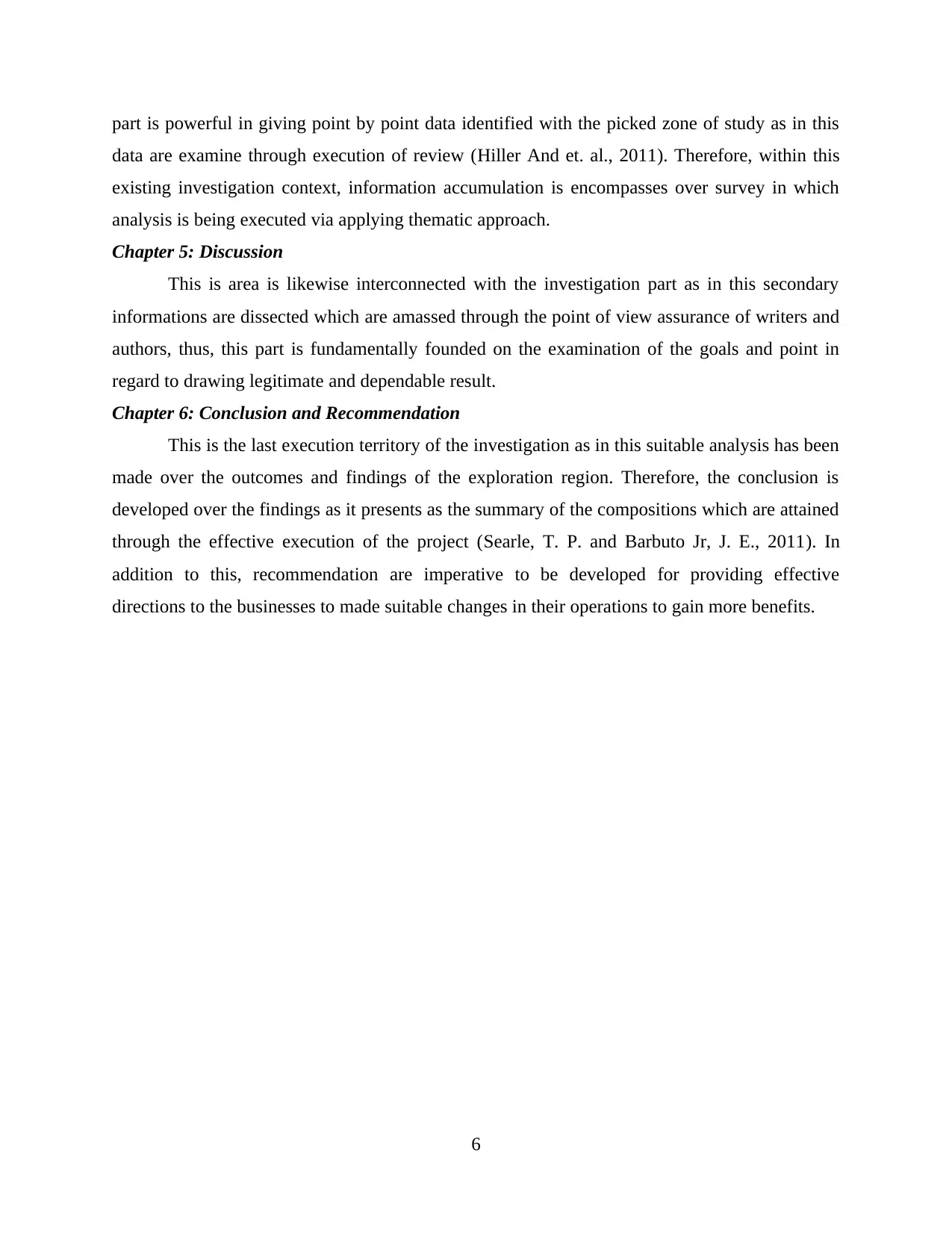
part is powerful in giving point by point data identified with the picked zone of study as in this
data are examine through execution of review (Hiller And et. al., 2011). Therefore, within this
existing investigation context, information accumulation is encompasses over survey in which
analysis is being executed via applying thematic approach.
Chapter 5: Discussion
This is area is likewise interconnected with the investigation part as in this secondary
informations are dissected which are amassed through the point of view assurance of writers and
authors, thus, this part is fundamentally founded on the examination of the goals and point in
regard to drawing legitimate and dependable result.
Chapter 6: Conclusion and Recommendation
This is the last execution territory of the investigation as in this suitable analysis has been
made over the outcomes and findings of the exploration region. Therefore, the conclusion is
developed over the findings as it presents as the summary of the compositions which are attained
through the effective execution of the project (Searle, T. P. and Barbuto Jr, J. E., 2011). In
addition to this, recommendation are imperative to be developed for providing effective
directions to the businesses to made suitable changes in their operations to gain more benefits.
6
data are examine through execution of review (Hiller And et. al., 2011). Therefore, within this
existing investigation context, information accumulation is encompasses over survey in which
analysis is being executed via applying thematic approach.
Chapter 5: Discussion
This is area is likewise interconnected with the investigation part as in this secondary
informations are dissected which are amassed through the point of view assurance of writers and
authors, thus, this part is fundamentally founded on the examination of the goals and point in
regard to drawing legitimate and dependable result.
Chapter 6: Conclusion and Recommendation
This is the last execution territory of the investigation as in this suitable analysis has been
made over the outcomes and findings of the exploration region. Therefore, the conclusion is
developed over the findings as it presents as the summary of the compositions which are attained
through the effective execution of the project (Searle, T. P. and Barbuto Jr, J. E., 2011). In
addition to this, recommendation are imperative to be developed for providing effective
directions to the businesses to made suitable changes in their operations to gain more benefits.
6
Paraphrase This Document
Need a fresh take? Get an instant paraphrase of this document with our AI Paraphraser
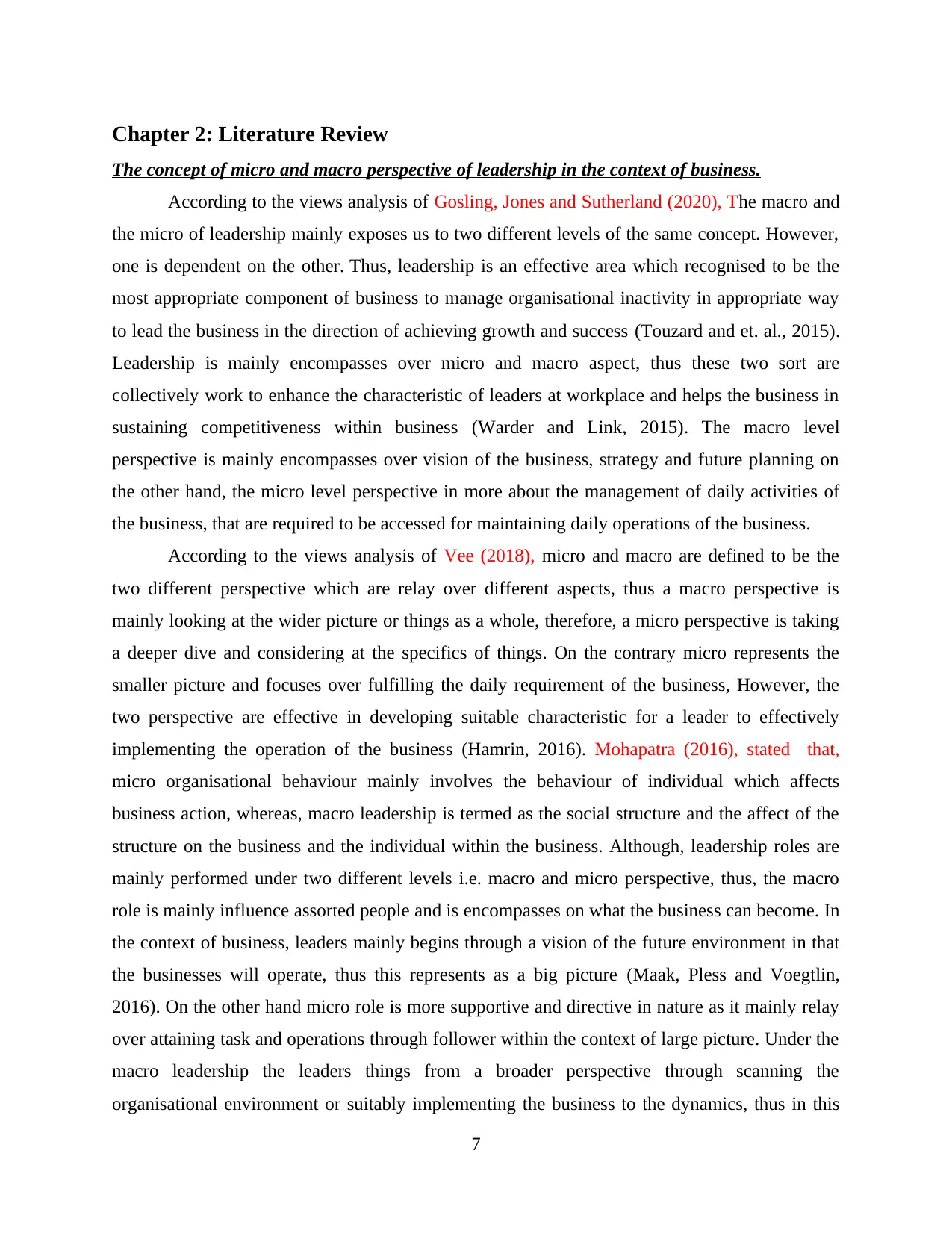
Chapter 2: Literature Review
The concept of micro and macro perspective of leadership in the context of business.
According to the views analysis of Gosling, Jones and Sutherland (2020), The macro and
the micro of leadership mainly exposes us to two different levels of the same concept. However,
one is dependent on the other. Thus, leadership is an effective area which recognised to be the
most appropriate component of business to manage organisational inactivity in appropriate way
to lead the business in the direction of achieving growth and success (Touzard and et. al., 2015).
Leadership is mainly encompasses over micro and macro aspect, thus these two sort are
collectively work to enhance the characteristic of leaders at workplace and helps the business in
sustaining competitiveness within business (Warder and Link, 2015). The macro level
perspective is mainly encompasses over vision of the business, strategy and future planning on
the other hand, the micro level perspective in more about the management of daily activities of
the business, that are required to be accessed for maintaining daily operations of the business.
According to the views analysis of Vee (2018), micro and macro are defined to be the
two different perspective which are relay over different aspects, thus a macro perspective is
mainly looking at the wider picture or things as a whole, therefore, a micro perspective is taking
a deeper dive and considering at the specifics of things. On the contrary micro represents the
smaller picture and focuses over fulfilling the daily requirement of the business, However, the
two perspective are effective in developing suitable characteristic for a leader to effectively
implementing the operation of the business (Hamrin, 2016). Mohapatra (2016), stated that,
micro organisational behaviour mainly involves the behaviour of individual which affects
business action, whereas, macro leadership is termed as the social structure and the affect of the
structure on the business and the individual within the business. Although, leadership roles are
mainly performed under two different levels i.e. macro and micro perspective, thus, the macro
role is mainly influence assorted people and is encompasses on what the business can become. In
the context of business, leaders mainly begins through a vision of the future environment in that
the businesses will operate, thus this represents as a big picture (Maak, Pless and Voegtlin,
2016). On the other hand micro role is more supportive and directive in nature as it mainly relay
over attaining task and operations through follower within the context of large picture. Under the
macro leadership the leaders things from a broader perspective through scanning the
organisational environment or suitably implementing the business to the dynamics, thus in this
7
The concept of micro and macro perspective of leadership in the context of business.
According to the views analysis of Gosling, Jones and Sutherland (2020), The macro and
the micro of leadership mainly exposes us to two different levels of the same concept. However,
one is dependent on the other. Thus, leadership is an effective area which recognised to be the
most appropriate component of business to manage organisational inactivity in appropriate way
to lead the business in the direction of achieving growth and success (Touzard and et. al., 2015).
Leadership is mainly encompasses over micro and macro aspect, thus these two sort are
collectively work to enhance the characteristic of leaders at workplace and helps the business in
sustaining competitiveness within business (Warder and Link, 2015). The macro level
perspective is mainly encompasses over vision of the business, strategy and future planning on
the other hand, the micro level perspective in more about the management of daily activities of
the business, that are required to be accessed for maintaining daily operations of the business.
According to the views analysis of Vee (2018), micro and macro are defined to be the
two different perspective which are relay over different aspects, thus a macro perspective is
mainly looking at the wider picture or things as a whole, therefore, a micro perspective is taking
a deeper dive and considering at the specifics of things. On the contrary micro represents the
smaller picture and focuses over fulfilling the daily requirement of the business, However, the
two perspective are effective in developing suitable characteristic for a leader to effectively
implementing the operation of the business (Hamrin, 2016). Mohapatra (2016), stated that,
micro organisational behaviour mainly involves the behaviour of individual which affects
business action, whereas, macro leadership is termed as the social structure and the affect of the
structure on the business and the individual within the business. Although, leadership roles are
mainly performed under two different levels i.e. macro and micro perspective, thus, the macro
role is mainly influence assorted people and is encompasses on what the business can become. In
the context of business, leaders mainly begins through a vision of the future environment in that
the businesses will operate, thus this represents as a big picture (Maak, Pless and Voegtlin,
2016). On the other hand micro role is more supportive and directive in nature as it mainly relay
over attaining task and operations through follower within the context of large picture. Under the
macro leadership the leaders things from a broader perspective through scanning the
organisational environment or suitably implementing the business to the dynamics, thus in this
7
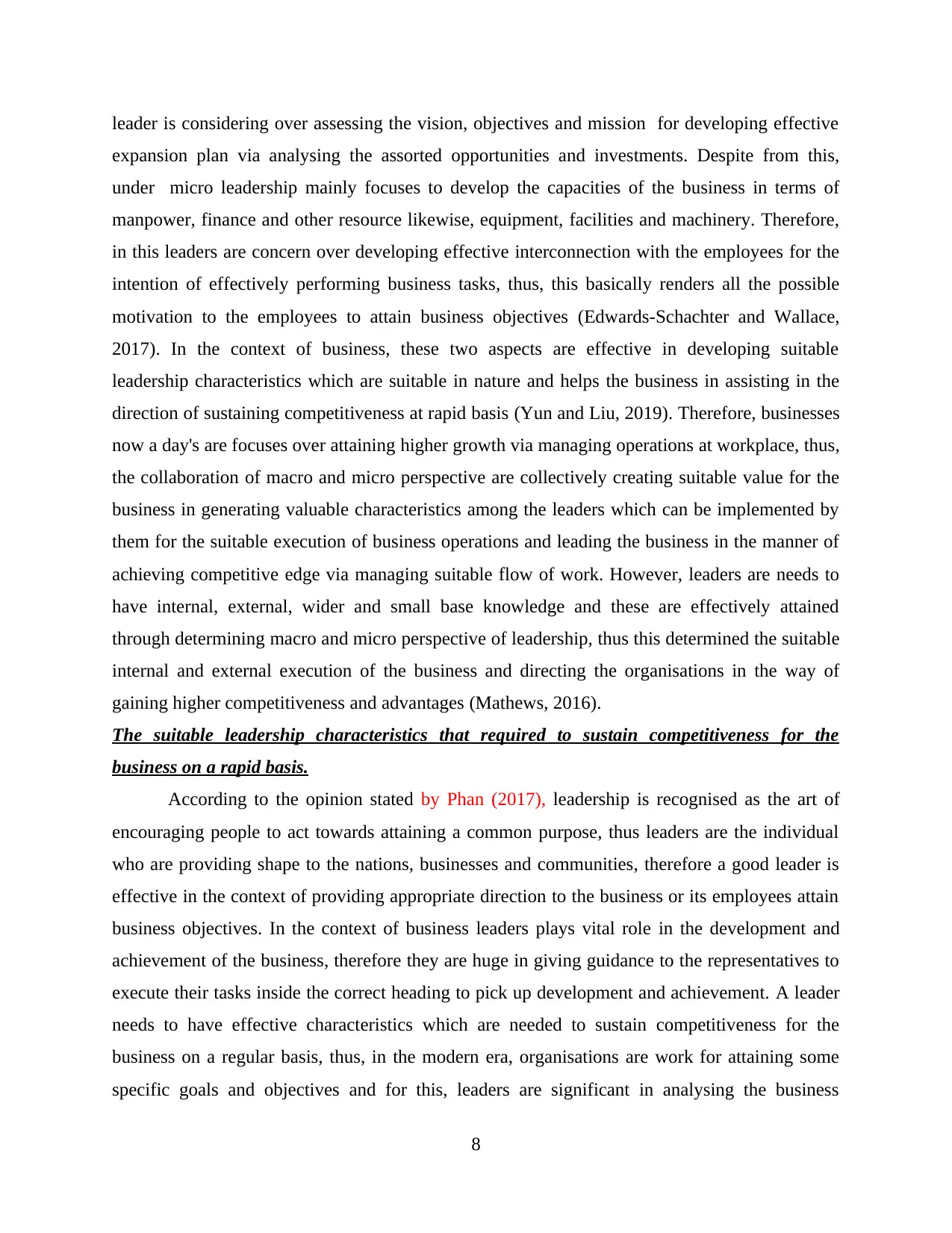
leader is considering over assessing the vision, objectives and mission for developing effective
expansion plan via analysing the assorted opportunities and investments. Despite from this,
under micro leadership mainly focuses to develop the capacities of the business in terms of
manpower, finance and other resource likewise, equipment, facilities and machinery. Therefore,
in this leaders are concern over developing effective interconnection with the employees for the
intention of effectively performing business tasks, thus, this basically renders all the possible
motivation to the employees to attain business objectives (Edwards-Schachter and Wallace,
2017). In the context of business, these two aspects are effective in developing suitable
leadership characteristics which are suitable in nature and helps the business in assisting in the
direction of sustaining competitiveness at rapid basis (Yun and Liu, 2019). Therefore, businesses
now a day's are focuses over attaining higher growth via managing operations at workplace, thus,
the collaboration of macro and micro perspective are collectively creating suitable value for the
business in generating valuable characteristics among the leaders which can be implemented by
them for the suitable execution of business operations and leading the business in the manner of
achieving competitive edge via managing suitable flow of work. However, leaders are needs to
have internal, external, wider and small base knowledge and these are effectively attained
through determining macro and micro perspective of leadership, thus this determined the suitable
internal and external execution of the business and directing the organisations in the way of
gaining higher competitiveness and advantages (Mathews, 2016).
The suitable leadership characteristics that required to sustain competitiveness for the
business on a rapid basis.
According to the opinion stated by Phan (2017), leadership is recognised as the art of
encouraging people to act towards attaining a common purpose, thus leaders are the individual
who are providing shape to the nations, businesses and communities, therefore a good leader is
effective in the context of providing appropriate direction to the business or its employees attain
business objectives. In the context of business leaders plays vital role in the development and
achievement of the business, therefore they are huge in giving guidance to the representatives to
execute their tasks inside the correct heading to pick up development and achievement. A leader
needs to have effective characteristics which are needed to sustain competitiveness for the
business on a regular basis, thus, in the modern era, organisations are work for attaining some
specific goals and objectives and for this, leaders are significant in analysing the business
8
expansion plan via analysing the assorted opportunities and investments. Despite from this,
under micro leadership mainly focuses to develop the capacities of the business in terms of
manpower, finance and other resource likewise, equipment, facilities and machinery. Therefore,
in this leaders are concern over developing effective interconnection with the employees for the
intention of effectively performing business tasks, thus, this basically renders all the possible
motivation to the employees to attain business objectives (Edwards-Schachter and Wallace,
2017). In the context of business, these two aspects are effective in developing suitable
leadership characteristics which are suitable in nature and helps the business in assisting in the
direction of sustaining competitiveness at rapid basis (Yun and Liu, 2019). Therefore, businesses
now a day's are focuses over attaining higher growth via managing operations at workplace, thus,
the collaboration of macro and micro perspective are collectively creating suitable value for the
business in generating valuable characteristics among the leaders which can be implemented by
them for the suitable execution of business operations and leading the business in the manner of
achieving competitive edge via managing suitable flow of work. However, leaders are needs to
have internal, external, wider and small base knowledge and these are effectively attained
through determining macro and micro perspective of leadership, thus this determined the suitable
internal and external execution of the business and directing the organisations in the way of
gaining higher competitiveness and advantages (Mathews, 2016).
The suitable leadership characteristics that required to sustain competitiveness for the
business on a rapid basis.
According to the opinion stated by Phan (2017), leadership is recognised as the art of
encouraging people to act towards attaining a common purpose, thus leaders are the individual
who are providing shape to the nations, businesses and communities, therefore a good leader is
effective in the context of providing appropriate direction to the business or its employees attain
business objectives. In the context of business leaders plays vital role in the development and
achievement of the business, therefore they are huge in giving guidance to the representatives to
execute their tasks inside the correct heading to pick up development and achievement. A leader
needs to have effective characteristics which are needed to sustain competitiveness for the
business on a regular basis, thus, in the modern era, organisations are work for attaining some
specific goals and objectives and for this, leaders are significant in analysing the business
8
⊘ This is a preview!⊘
Do you want full access?
Subscribe today to unlock all pages.

Trusted by 1+ million students worldwide
1 out of 75
Related Documents
Your All-in-One AI-Powered Toolkit for Academic Success.
+13062052269
info@desklib.com
Available 24*7 on WhatsApp / Email
![[object Object]](/_next/static/media/star-bottom.7253800d.svg)
Unlock your academic potential
Copyright © 2020–2025 A2Z Services. All Rights Reserved. Developed and managed by ZUCOL.





